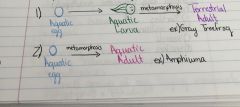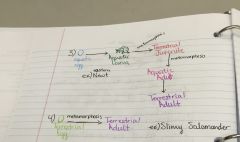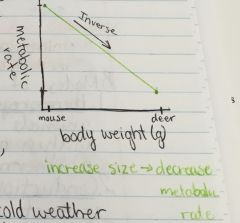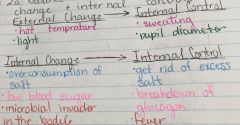![]()
![]()
![]()
Use LEFT and RIGHT arrow keys to navigate between flashcards;
Use UP and DOWN arrow keys to flip the card;
H to show hint;
A reads text to speech;
56 Cards in this Set
- Front
- Back
|
History of Vertebrates |
1. 540 million years ago first evidence of vertebrates 2. 540-360 million years restricted to the oceans 3. 360 million years: evolution of legs & feet ---> move to land ---> diversification (amphibians, reptiles, birds, mammals) |
|
|
Chordates (Domain Eukarya, Kingdom Animalia, Phylum Chordata) |
1. deuterostomes with 4 key features (present only during development or present during development & adulthood) 2. evolved from an ancestral deuterostome 3. sister group to chordates are the echinoderms |
|
|
Deuterostome |
animals with an anus derived from the blastopore |
|
|
Echinoderms |
1. sea stars, sea urchins, sand dollar, brittle stars, sea cucumber 2. tube feet and water vascular system 3. spines embedded in the dermis |
|
|
Chordate Characteristics |
1. notochords 2. dorsal, hollow nerve cord 3. pharyngeal slits 4. muscular post-anal tail |
|
|
Notochords |
longitudinal flexible rod located between the digestive tube & the nerve cord |
|
|
Dorsal, Hollow Nerve Cord |
develops into the central nervous system (CNS) in some chordates (brain ---> spinal cord) |
|
|
Pharyngeal Slits |
series of pouches separated by grooves along the pharynx (some gills, some only present during embryonic development, some only present in early development) |
|
|
Muscular Post-Anal Tail |
tail extending posterior to the anus |
|
|
Chordate Groups |
1. Cephalochordates (lancelets) 2. Urochordates (tunicates) 3. Craniates |
|
|
Cephalochordates (lancelets) |
1. invertebrates 2. marine filter feeders 3. retain all chordate features as adults |
|
|
Urochordates (tunicates) |
1. invertebrates 2. marine filter feeders 3. loose some chordate features as adults |
|
|
Craniates |
1. chordates that have a head: skull, brain, eyes, other sensory organs 2. hagfishes |
|
|
Hagfishes |
1. jawless marine craniates 2. not vertebrates 3. cartilaginous skull 4. axial rod of cartilage derived from the notochord 5. "slime eel" |
|
|
Vertebrae Classification |
1. craniates with a backbone 2. have vertebrae 3. 8/9 classes of vertebrates |
|
|
Vertebrae |
series of bones composing the vertebral column (backbone) |
|
|
Gnathostomes |
vertebrates with jaws |
|
|
Jaws |
hinged structures that grip food & slice food |
|
|
Osteichthyans |
1. bony (ossified) endoskeleton 2. no teeth (birds, many amphibians, turtles) 3. aquatic (ray-finned fishes [ex. striped bass]) & terrestrial (amphibians, reptiles, mammals, birds) |
|
|
Ossified |
has deposits of calcium phosphate |
|
|
Lobe-fins |
1. rod-shaped bones extending from the body surrounded by muscle 2. coelacanths (lobe-finned fish) 3. salamanders (lobe-finned tetrapod) 4. ancestors of tetrapods |
|
|
Tetrapods |
1. vertebrates with 4 feet (limbs) & associated appendages 2. much variability (frogs, cows, eagles, amphibians, reptiles, mammals, birds) |
|
|
Amniotes |
1. tetrapods with a terrestrially adopted egg or "amniote egg" |
|
|
Amniote Egg |
1. contains extra embryonic membranes that develop into tissue layers that grow out of embryo 2. functions in gas exchange, waste storage, and nutrient adaptions 2. terrestrial adaptions: shell, other membranes, strategy for survival & fitness for a life on land, do not have to rely on water for egg deposition
|
|
|
Vertebrate Classes |
1. Lampreys 2. Chondrichthyes 3. Ray-finned fishes 4. Coelacanth 5. Lung fishes 6. Amphibia 7. Reptilia 8. Birds 9. Mammalia |
|
|
Lampreys (Petromyzontida) |
1. oldest living lineage of vertebrates 2. parasites of other vertebrates 3. jawless vertebrates |
|
|
Chondrichthyes (Chondrichthyans) |
1. "cartilage fish" 2. skeleton mostly of cartilage 3. ex) sharks, rays, chimeras (ratfish) |
|
|
Ray-Finned Fishes |
1. have fins supported by long, flexible rays (extensions of the endoskeleton) 2. rays support the fin & function as defense 3. most diverse group of fishes 4. diversity is threatened by habitat loss (overfishing) |
|
|
Coelacanth |
1. lobe-finned fish 2. few extant representatives |
|
|
Lung Fishes |
1. lungs or lung derivatives |
|
|
Amphibia (Amphibians) = "amphi": both |
1. moist skin used for gas exchange 2. lungs often present 3. biphasic life cycle: aquatic and terrestrial 4. reproductive strategy |
|
|
Reproductive Strategy of Amphibians Part 1 |

|
|
|
Reproductive Strategy of Amphibians Part 2 |

|
|
|
Major Amphibian Group Diversity |
1. frogs and toads 2. salamanders 3. caecilians |
|
|
Reptilia (Reptiles) |
1. body covered in scales (keratinized) 2. use lungs for gas exchange 3. shelled egg (amniote tetrapod) 4. reptile diversity (turtles, crocodilians, lizards, snakes) |
|
|
Birds (Aves) |
1. evolved from a small group of carnivorous dinosaurs (theropods) 2. common features (reptiles vs. birds): feathers are modified scales, scaled legs, shelled eggs 3. adaptions for flight: feathers, light skull, no bladder, small gonads, no teeth |
|
|
Bird Diversity |
1. water fowl 2. wading birds 3. chicken-like birds 4. passerines (warblers, sparrows, finches, vireos) 5. alcids (penguins) 6. gulls |
|
|
Mammalia (Mammals) |
1. amniotes 2. hair 3. mammary glands (produce milk) |
|
|
Primary Mammal Groups |
1. Monotremes 2. Marsupial 3. Eutherians (placental mammals) |
|
|
Monotremes |
1. small group of egg laying mammals 2. platypus & echidna |
|
|
Marsupial |
1. young begin embryonic development attached to a placenta in the uterus but completes development in a maternal pouch 2. opossums, kangaroo, koalas, sugar gliders |
|
|
Eutherians (Placental Mammals) |
1. have young that completes embryonic development attached to a placenta in the uterus 2. 18 orders: Sirenia (Manatee), Carnivora (Wolves), Rodentia (Squirrels), Primata (Chimps), Cetacea (Dolphins) |
|
|
Bioenergetic Strategies |
1. endothermic strategy: uses metabolic heat to maintain a fairly constant body temp (ex. mammals and birds) 2. endotherms: "inside or within" warm blooded animals 3.ectothermic strategy: rely on external sources of heat for maintaining body temp (ex. reptiles, amphibians, fishes, invertebrates) 4. ectotherms: "external or outside" cold blooded animals |
|
|
Influences on Metabolic Rate |
1. metabolic rate/gram of animal is inversely related to to body size among similar animals (endoderm vs. ectoderm) 2. one hypothesis 3. energy budgets |
|
|
Hypothesis |

1. for endotherms the smaller the animals, the greater the cost of keeping a stable internal temperature 2. the smaller the animal the greater the surface to volume ratio 3. fast loss of heat in cold weather 4. fast gain of heat in hot weather |
|
|
Energy Budgets |
1. basal metabolic rate 2. activity 3. temperature 4. growth 5. reproduction |
|
|
Internal Regulation |
1. homeostasis 2. modes of heat exchange 3. balancing heat gain & loss |
|
|
Homeostasis |

1. an animal's internal steady state 2. a balance between external change & internal controls |
|
|
Modes of Heat Exchange |

1. thermoregulations: the process by which animals maintain internal temps within a favorable range (thermoregulators) 2. conduction: heat transfer by direct contact 3. convection: indirect transfer of heat through convection currents 4. radiation: electromagnetic spectrum; specifically ultraviolet light 5. evaporation: evaporative cooling (property of water) |
|
|
Balancing Heat Gain & Loss |
1. behavioral adjustments: panting, bathing, sweating 2. physiological adjustments 3. insulation 4. countercurrent heat exchange |
|
|
Physiological Adjustments |
1. vasoconstriction: decrease in the diameter of blood vessels near the body surface "goosebumps" & warms the body 2. vasodilation: increases in the diameter of blood vessels near the surface to release heat & cool the body |
|
|
Insulation |
1. hair 2. fat |
|
|
Countercurrent Heat Exchange |
1. warms blood before it enters the body 2. warms appendages |
|
|
Torpor |
1. conserves energy during environmental extremes by decreasing metabolic rate 2. environmental extremes 3. hibernation (torpor in winter) 4. estivation 5. daily torpor (during sleep periods) |
|
|
Environmental Extremes |
1. hot weather 2. cold weather 3. drought 4. lack of food |
|
|
Estivation |
1. torpor in summer or drought 2. ex) siren (large salamander) burrows into mud when wetlands dry (completely aquatic salamander) 3. ex) easter spade foot toad |

